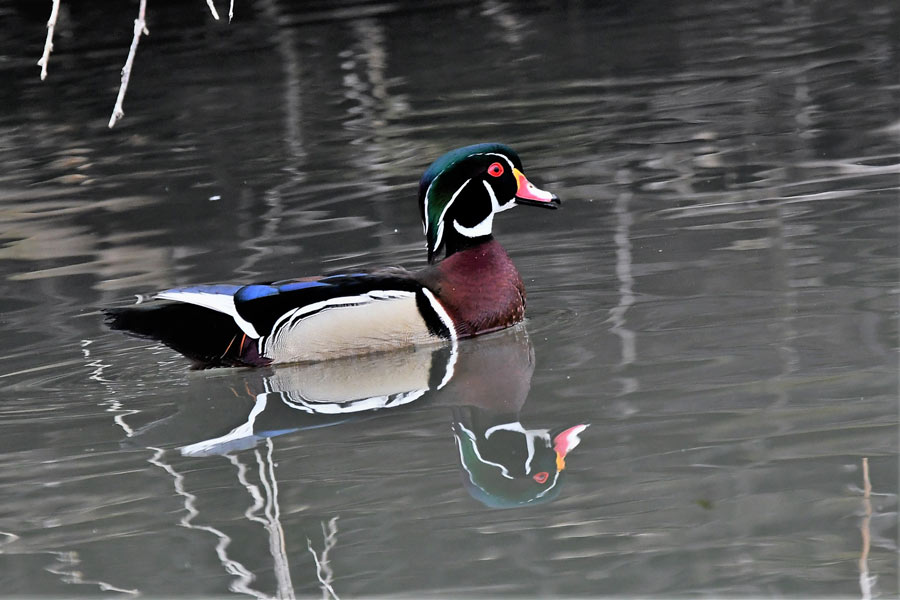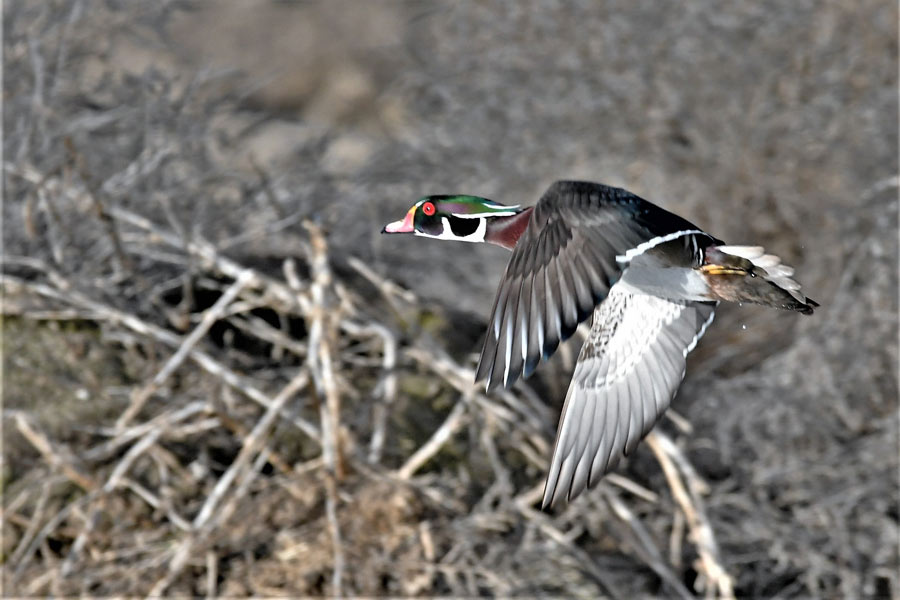While searching for hooded mergansers on Henrys Fork, I encountered the migrating ‘wood duck social club’
Published at | Updated at
While trying to photograph some hooded mergansers one evening near the confluence of the Henrys Fork and the South Fork of the Snake River, I saw what appeared to be several Wood ducks. They were not close, but with my binoculars, I identified them and as I watched four pair emerge from under a willow. They were near a cattle feed yard and near a farmhouse. I had only two very poor pictures of them and wanted to get some good ones.
For two days, I parked next to a bridge hoping (and praying) that eventually they would follow some of the hoodies, move up the canal and swim under the bridge. No such luck. Since they fed on plants and seeds instead of fish, they were content to play around without coming closer. Three of them eventually flew up past the bridge and I did get some fairly good shots. Time to knock on a door – no answer – so I flagged down a car, got a phone number and called.
After getting permission from the family (one of the sons was a former student of mine), I was allowed to park in their pasture next to the canal. I was in the middle of the migrating “Wood Duck Social Club” with 16 “woodies” playing around on the canal. They allowed me to photograph them for about three hours before my movement was noticed by a wise old hen and all of them disappeared.
I hadn’t seen them fly away and my former student came to visit and said that there were a few further down the canal. I drove down and sure enough, eight flew out from under a willow hanging over the water. A huge mistake – they were gone for the day.

The next morning was foggy and I got there a little earlier and parked near the willow where the ducks had hidden the day before. Eleven of them played near the willow but stayed under it, which getting pictures a little difficult. I was about to leave when three small flocks of woodies flew in, landing in the canal below and above me.
“Fresh ones,” I thought as 31 of them started working toward me.
As I began snapping photos, everything flew off, including a Great blue heron down the canal. A Bald eagle was looking for breakfast and none of the waterfowl were ready to be put on its platter. In most of their wintering areas, woodies can be hunted, and I found them very shy and spooked by vehicles and movement in them. Wild ones are difficult to photograph.
Most of these woodies were migrating from Mexico, Arizona, New Mexico, or California and were most likely headed to southern Canada. I visited the canal this week and found all but one pair were gone. The Department of Fish and Game reported to me, that like the hoodies, there are a few that nest from the Chester area down to Roberts.
Like the hoodies, Wood ducks are cavity nesters, but they are a little larger and need at least a four-inch hole in a tree to make a nest. In eastern Idaho wetlands, there are not many trees with a four-inch hole for them to find. They cannot excavate their own hole, so they need to find one suitable for them. Some landowners in the St. Anthony area have private ponds and put out nest boxes for them and woodies have nested in them.

There have been plastic nest boxes placed for them in different areas, but studies have shown that the plastic gets too hot, and the nests have been abandoned. Wooden boxes about 24 inches deep with a 10-inch square floor and cavity with a four- to five-inch hole are what the females look for while picking somewhere to raise their broods. In ideal locations, they will raise two broods per year.
I have built several nest boxes and will be placing them next fall on private properties that have given me permission to do so. Hopefully, we can get a few more woodies to stay during the summer so they will be more visible for us to enjoy. The males are stunning to see and they are fun to watch.
Searching for them in canals, side channels on area rivers and on ponds can be productive. Warm Slough, Texas Canal, the Henrys Fork near St. Anthony, private ponds and the South Fork of the Teton west of Rexburg are all good places to see them.
Check your waste seeds under your bird feeders — a friend of mine found a pair cleaning up his backyard this week! If you’re looking for some, good luck!
Living the Wild Life is brought to you by The Healing Sanctuary.


